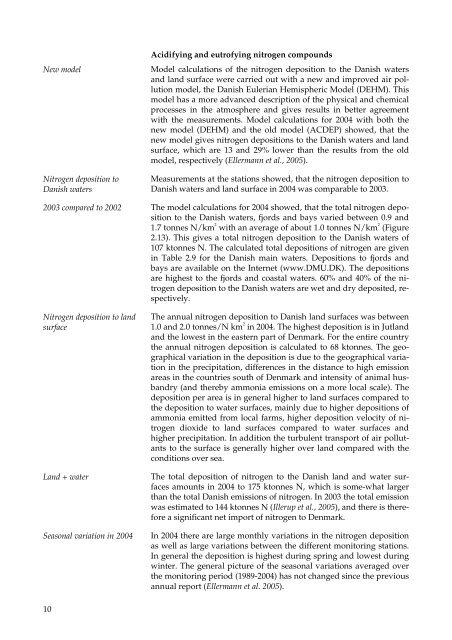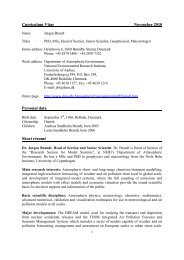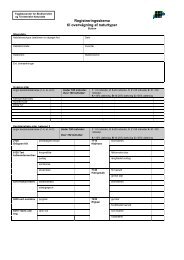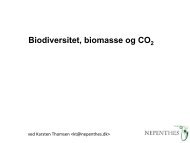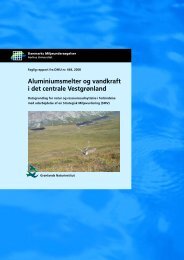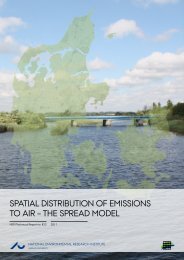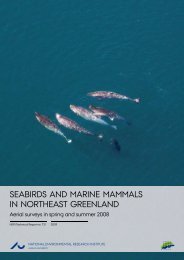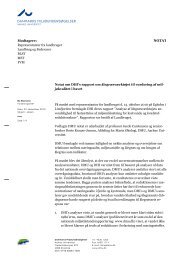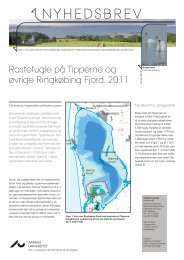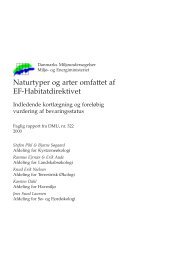Atmosfærisk deposition, driftsrapport for luft- forurening i 2004
Atmosfærisk deposition, driftsrapport for luft- forurening i 2004
Atmosfærisk deposition, driftsrapport for luft- forurening i 2004
You also want an ePaper? Increase the reach of your titles
YUMPU automatically turns print PDFs into web optimized ePapers that Google loves.
New model<br />
Nitrogen <strong>deposition</strong> to<br />
Danish waters<br />
2003 compared to 2002<br />
Nitrogen <strong>deposition</strong> to land<br />
surface<br />
Land + water<br />
Seasonal variation in <strong>2004</strong><br />
10<br />
Acidifying and eutrofying nitrogen compounds<br />
Model calculations of the nitrogen <strong>deposition</strong> to the Danish waters<br />
and land surface were carried out with a new and improved air pollution<br />
model, the Danish Eulerian Hemispheric Model (DEHM). This<br />
model has a more advanced description of the physical and chemical<br />
processes in the atmosphere and gives results in better agreement<br />
with the measurements. Model calculations <strong>for</strong> <strong>2004</strong> with both the<br />
new model (DEHM) and the old model (ACDEP) showed, that the<br />
new model gives nitrogen <strong>deposition</strong>s to the Danish waters and land<br />
surface, which are 13 and 29% lower than the results from the old<br />
model, respectively (Ellermann et al., 2005).<br />
Measurements at the stations showed, that the nitrogen <strong>deposition</strong> to<br />
Danish waters and land surface in <strong>2004</strong> was comparable to 2003.<br />
The model calculations <strong>for</strong> <strong>2004</strong> showed, that the total nitrogen <strong>deposition</strong><br />
to the Danish waters, fjords and bays varied between 0.9 and<br />
1.7 tonnes N/km 2<br />
with an average of about 1.0 tonnes N/km 2<br />
(Figure<br />
2.13). This gives a total nitrogen <strong>deposition</strong> to the Danish waters of<br />
107 ktonnes N. The calculated total <strong>deposition</strong>s of nitrogen are given<br />
in Table 2.9 <strong>for</strong> the Danish main waters. Depositions to fjords and<br />
bays are available on the Internet (www.DMU.DK). The <strong>deposition</strong>s<br />
are highest to the fjords and coastal waters. 60% and 40% of the nitrogen<br />
<strong>deposition</strong> to the Danish waters are wet and dry deposited, respectively.<br />
The annual nitrogen <strong>deposition</strong> to Danish land surfaces was between<br />
1.0 and 2.0 tonnes/N km 2 in <strong>2004</strong>. The highest <strong>deposition</strong> is in Jutland<br />
and the lowest in the eastern part of Denmark. For the entire country<br />
the annual nitrogen <strong>deposition</strong> is calculated to 68 ktonnes. The geographical<br />
variation in the <strong>deposition</strong> is due to the geographical variation<br />
in the precipitation, differences in the distance to high emission<br />
areas in the countries south of Denmark and intensity of animal husbandry<br />
(and thereby ammonia emissions on a more local scale). The<br />
<strong>deposition</strong> per area is in general higher to land surfaces compared to<br />
the <strong>deposition</strong> to water surfaces, mainly due to higher <strong>deposition</strong>s of<br />
ammonia emitted from local farms, higher <strong>deposition</strong> velocity of nitrogen<br />
dioxide to land surfaces compared to water surfaces and<br />
higher precipitation. In addition the turbulent transport of air pollutants<br />
to the surface is generally higher over land compared with the<br />
conditions over sea.<br />
The total <strong>deposition</strong> of nitrogen to the Danish land and water surfaces<br />
amounts in <strong>2004</strong> to 175 ktonnes N, which is some-what larger<br />
than the total Danish emissions of nitrogen. In 2003 the total emission<br />
was estimated to 144 ktonnes N (Illerup et al., 2005), and there is there<strong>for</strong>e<br />
a significant net import of nitrogen to Denmark.<br />
In <strong>2004</strong> there are large monthly variations in the nitrogen <strong>deposition</strong><br />
as well as large variations between the different monitoring stations.<br />
In general the <strong>deposition</strong> is highest during spring and lowest during<br />
winter. The general picture of the seasonal variations averaged over<br />
the monitoring period (1989-<strong>2004</strong>) has not changed since the previous<br />
annual report (Ellermann et al. 2005).


